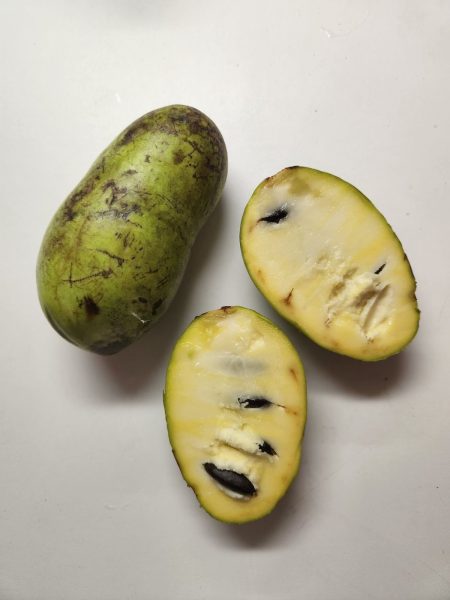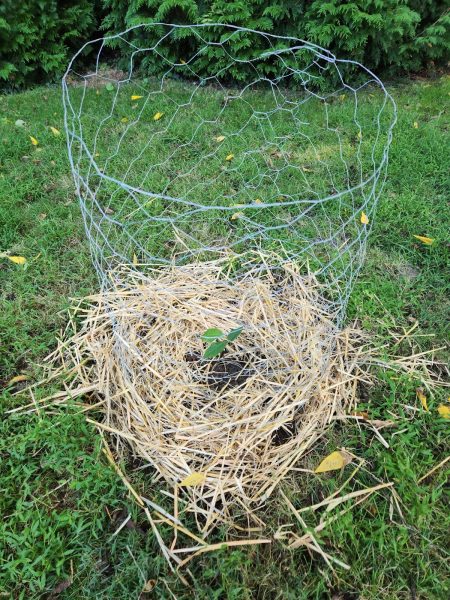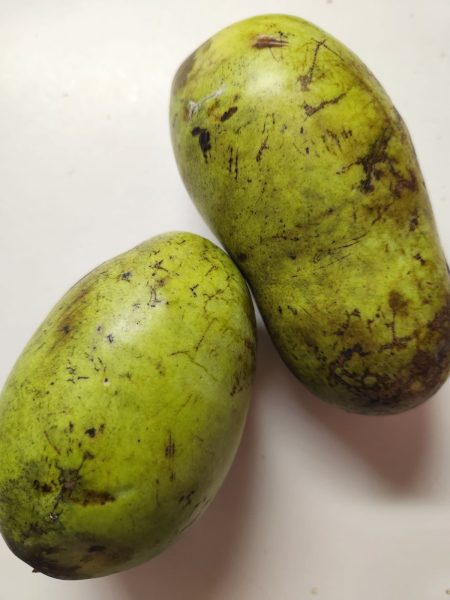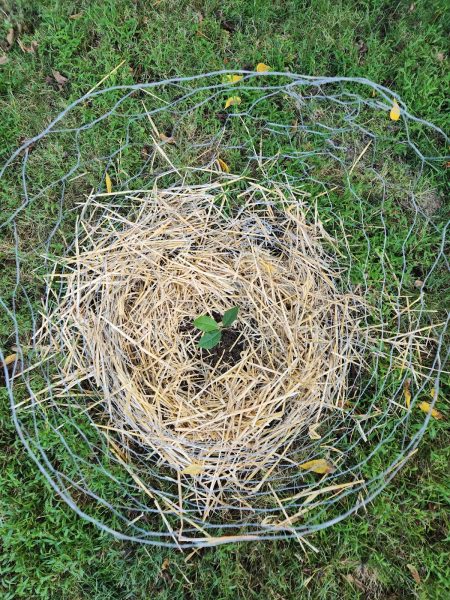If you’ve never heard of the fruit and tree known as Pawpaw, you’re not alone, and if you have heard of it, chances are you’re a big fan. As the largest edible fruit native to North America, the Pawpaw has a lot to offer, but it has largely gone under-appreciated in recent years.
Small Tree, Big Fruit
Let’s start with the basics of what a Pawpaw is. Scientifically known as Asimina triloba, this tree is one of 13 species in the Asimina genus of the custard apple family. All other Asimina custard apples are found only in the southeastern US, while A. triloba makes it to southern Ontario, Canada. The Pawpaw’s seed dispersal has been the subject of much study. There is evidence that it originally evolved alongside North America’s megafauna being dispersed by Giant Ground Sloths and others. Once the megafauna species went extinct, it is very likely that Pawpaw was mainly dispersed across long distances by indigenous people. Certainly today those who know and have Pawpaws are often enthusiastic about them and help in propagating the tree.

The process of producing a Pawpaw fruit is slow. It takes about 5 to 7 years for the tree to get big enough to even try to produce a fruit. Once old enough, this small tree gets its reproductive process started early in the growing season. In early spring, an A. triloba tree breaks bud and puts out flowers that attract flies and beetles rather than the more famous pollinators like bees and butterflies. An individual Pawpaw tree is not able to pollinate itself – it must get pollen from another genetically different Pawpaw individual. Of course, this gets confusing when you consider that one Pawpaw tree can produce clones of itself through root sprouts. What might look like a patch of many Pawpaw trees may be all the same tree with all the same DNA. Upon the successful delivery of genetically different Pawpaw pollen to a Pawpaw flower, the development of the fruit starts and won’t be finished for many months. Come September and October, the fruits of all that photosynthesizing become ripe and ready for enjoyment. Songbirds, wild turkeys, raccoons, opossums, foxes, and black bears all eat Pawpaw; but in my experience, plenty of Pawpaw fruits don’t get eaten, falling to the ground to feed the soil instead. Unless, of course, people come along in time.
Enjoying Pawpaw
Pawpaw fruits are delicious. Eat them fresh, add them to vanilla ice cream, or blend them into a smoothie. The Iroquois enjoyed taking dried Pawpaw fruit with them on hunting trips and would rehydrate Pawpaw cakes to make sauces or mix into cornbread. Pawpaw was also a traditional food for the Cherokee who called it “disunki”, the Shawnee who called it “ha’siminikiisfwa” and the Lenape who called it “mahchikpia,” among others.

It is difficult to describe the flavor of a Pawpaw. I can remember being confused by descriptions before I tried my first, yet still, I will try to explain it for the uninitiated. Its current name, Pawpaw, is a derivative of the word “papaya.” I can see why it was compared to that other fruit, mostly for their similarity in texture. The term “custard apple,” which is applied to its entire genus, is also a decent description, but the apple flavor is mixed with that of a banana, and something else – maybe some citrus. The flavor is also similar to a ripe jackfruit. Overall, the flavor is fairly mild and pairs well with others. There are plenty of recipes on the internet for making muffins, puddings, smoothies, and ice cream with them, or drying and dipping them in chocolate. You likely won’t find Pawpaw in your local grocery store because they don’t last very long and bruise easily. If you get the chance to harvest them in the wild or find a friend who will give you some from their backyard, don’t miss the opportunity.
The Importance of Pawpaw
A lot changed after the arrival of English colonists on the east coast of this continent. The impacts of colonization most relevant to the role of Pawpaw in our local ecosystem include:
- the exchange of plants between long-separated continents,
- the systematic hunting-off of the biggest herbivores like elk and the major predators like wolves and mountain lions,
- and the centuries of attacks on North American indigenous peoples and cultures.
In the case of 1 and 2, Pawpaw is largely a winner. People have now spread this species to places as far away as Italy. While it’s true that at home in its native range, Pawpaw now has to compete with a whole host of invasive plant species as a result of our plant trade, that competition is made easier by the fact that white-tailed deer are now the dominant herbivores in our forests. With elk not around to bully the deer away from the best browsing and grazing spots and the wolves and mountain lions no longer here to limit their numbers, white-tailed deer now have a lot of influence over which plants thrive and which struggle. In general, deer don’t like to eat Pawpaw – a fact that is good for Pawpaw in two ways. First, Pawpaw doesn’t have to spend energy recovering from deer bites. Second, it can move into the spaces left behind by plants that died because the deer like to eat them. On the whole, Pawpaw has fared well through the ecological restructuring that has taken place over the past several centuries.
In the case of 3, centuries of attacks on North American indigenous peoples and cultures, Pawpaw is a survivor and a beacon. Colonists brought food crops from their homelands out of necessity and nostalgia as many immigrants do. What earns a colonist the label “colonist,” however, is the active destruction and effort to replace the indigenous people and culture already present. The colonist society’s tools of violence, displacement, and appropriation were and are applied to crops and foods just as they were and are applied directly to indigenous people. Pawpaw is a survivor of these attacks, but risks being a victim of appropriation if we don’t remember and honor its history.


When William Penn’s sons and subsequent colonist leaders used bad-faith treaties along with threats and violence to ultimately remove the Lenape and other native peoples from Pennsylvania, they weren’t just claiming resources for their side. Displacement from homelands includes displacement from the plants and animals unique to those places; the plants and animals that Lenape culture was and is influenced by and built around. Currently, two Lenape tribes live in Oklahoma where Pawpaw and other traditional foods of the Lenape do not grow. Another lives in Ontario, on the very edges of the Pawpaw’s range. The Lenape have gone through periods of dependency on the US federal government for food aid – a service needed only because the actions of the US government left them poor and in unfamiliar territory. Food aid rations consisted of foods high in calories and low in nutritional value like lard, flour, coffee, sugar, and canned meat. Today, there is a growing movement to return to traditional foods and restore indigenous food sovereignty. Pawpaw can be a part of that effort.
Final Thoughts for Pawpaw
There is so much to appreciate about the Pawpaw. This small tree bucks so many commonly held assumptions about plants and ecology, from which insects are responsible for pollination, to what fruit in North America looks and tastes like, to how we define the individual.

It is a winner, a survivor, a beacon. Pawpaw may never make it into the mainstream of American culture, but I hope that today it has gained at least one more fan.
Katie Toner, Conservation Easement Steward
Curious about pollinators, wineberries, mushrooms, turtle crossings, reforestation, and other woodsy things? Read more Nature Notes.
